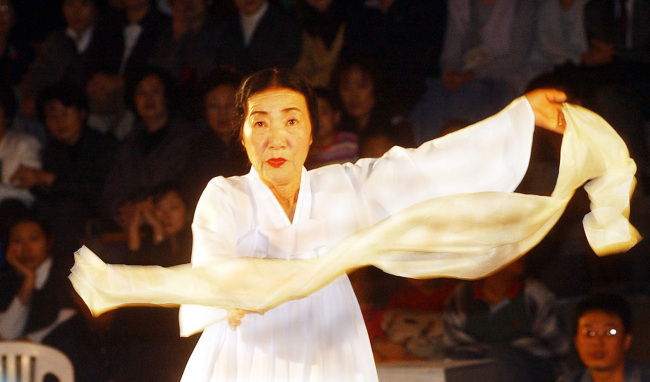Korea’s legendary traditional folk dancer Gong Ok-jin died in Yeonggwang, South Jeolla Province, on Monday. She was 81.
Gong, who was designated intangible cultural heritage, had been undergoing medical treatment for the last 14 years, after suffering a stroke in 1998.
Born in 1931 in South Jeolla Province to a pansori artist family, Gong was once taught by the famous late modern dancer Choi Seung-hee (1911-1969) in Japan, and joined the Joseon Changgeukdan, a Korean traditional opera troupe, in 1945.
Gong is recognized for the creation of her original repertoire, which combines Korea’s traditional folk dance with her own, animal-movement-inspired choreography. Gong would often incorporate movements imitating animals, such as apes and puma, while showcasing traditional folk dance techniques at the same time.
Gong, who was designated intangible cultural heritage, had been undergoing medical treatment for the last 14 years, after suffering a stroke in 1998.
Born in 1931 in South Jeolla Province to a pansori artist family, Gong was once taught by the famous late modern dancer Choi Seung-hee (1911-1969) in Japan, and joined the Joseon Changgeukdan, a Korean traditional opera troupe, in 1945.
Gong is recognized for the creation of her original repertoire, which combines Korea’s traditional folk dance with her own, animal-movement-inspired choreography. Gong would often incorporate movements imitating animals, such as apes and puma, while showcasing traditional folk dance techniques at the same time.

The dancer was also famous for her own interpretation of the “hunchback-dance,” where she would place a pillow or a bucket on her back to imitate the movements of the physically disabled. This particular dance belongs to the category of Korea’s traditional dance called “Byung-shin chum,” literally translated as “dance of the handicapped.”
The dance was first developed and performed by the lower class peasants during the Joseon dynasty to satirize aristocrats, by depicting them as persons with physical disabilities, such as hunchbacks, or people with hearing or visual disabilities. Gong’s national tour was a huge hit during the ‘70s.
During the ‘90s, Gong became the first Asian artist to perform at the Lincoln Center for the Performing Arts in New York. She was designated intangible heritage in 2010, for her pansori-dance one-man play “Simcheong-ga,” which was based on the famous Korean folklore of filial piety. The artist’s designation as intangible cultural heritage had previously been rejected many times by the authorities, as some claimed that Gong created her own dances, rather than practicing and performing Korea’s traditional folk dance in its original form and style.
Gong suffered financial difficulties and illness in her later years; she had been relying on government welfare payments for the impoverished since 2007.
Gong’s last dance performance took place in 2010, at the National Theater of Korea in Seoul. The artist was also known as the great aunt of popular K-pop group 2NE1 member Minzy.
By Claire Lee (dyc@heraldcorp.com)





![[KH Explains] No more 'Michael' at Kakao Games](http://res.heraldm.com/phpwas/restmb_idxmake.php?idx=644&simg=/content/image/2024/04/28/20240428050183_0.jpg&u=20240428180321)













